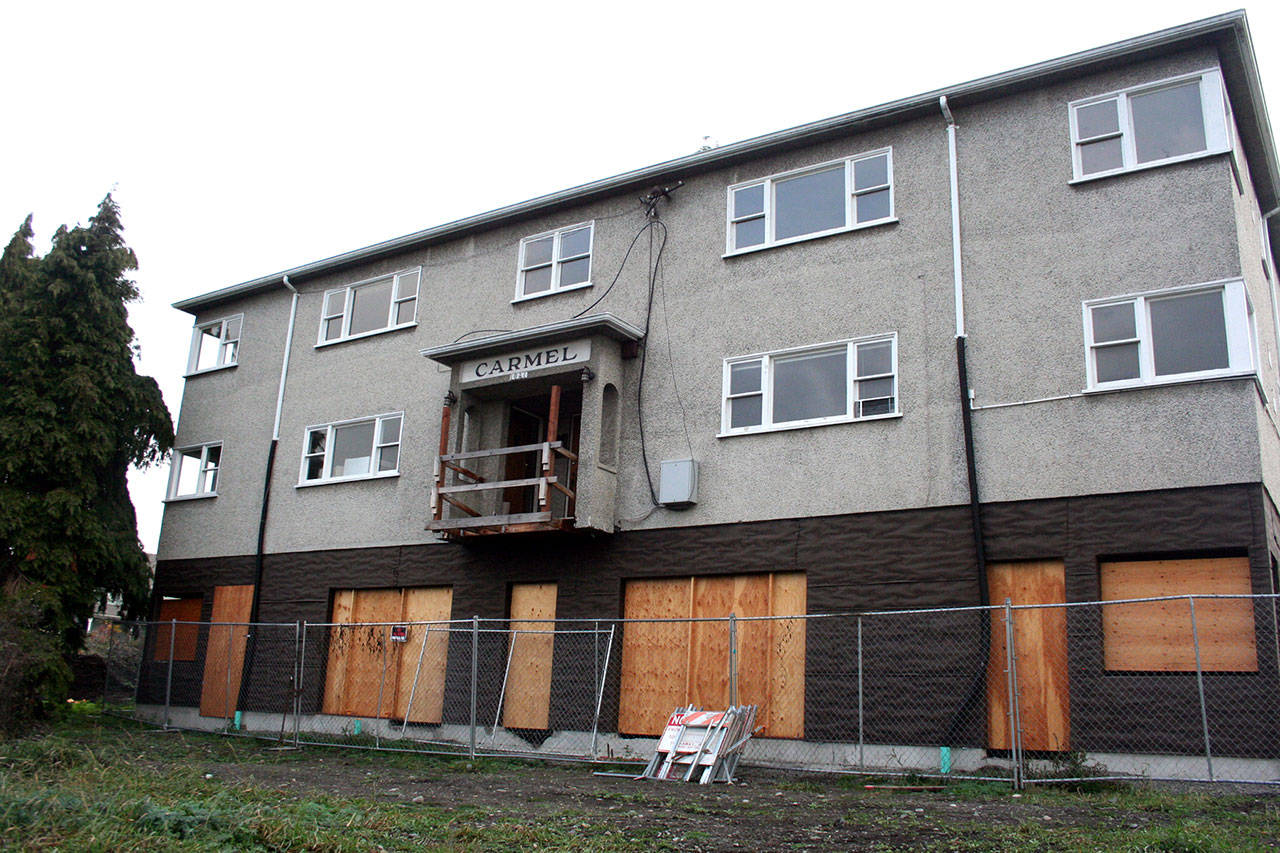PORT TOWNSEND — The Cherry Street project might have tenants by the end of next December, but it could cost twice as much as the original estimate.
Representatives from Homeward Bound Community Land Trust, a nonprofit that partnered with the city of Port Townsend to barge the Carmel building from Victoria, told Port Townsend City Council members Tuesday night they have a new timeline and budget projection for the eight-unit complex.
Estimates are now between $1.3 million and $1.8 million, including infrastructure costs, said Paul Rice, the vice president of the Homeward Bound board.
“This project is not as turn-key as originally imagined,” Rice said. “Perhaps some people expected that, but we’re finding it’s going to cost more than the $834,000 that was projected.”
On a night that the council had public hearings on two ordinances intended to make it easier for developers to build multi-family residences and affordable housing projects, it also passed a resolution that declares the council’s intent to authorize a sales and use tax — a small credit from the existing state sales tax — to support affordable housing.
As one of the only projects the city has underway, the Carmel building near Cherry and Van Ness streets took center stage.
Rice presented Homeward Bound’s findings during a special presentation that followed a similar one from the affordable housing and homeless housing committee, a joint city-county task force that recently finalized a five-year plan which shows a need for 300 additional housing units by the end of 2024.
The city provided Homeward Bound the $834,000 with a 40-year bond term in May 2018, one year after the building was pulled across the Strait of Juan de Fuca from Victoria.
The first payment of more than $23,000 is due July 1, although Rice said Tuesday the organization likely will ask for a deferral until July 2021.
Homeward Bound has reorganized its board this year, and only three original members remain, Rice said.
“Before this year, we didn’t have a good sense of the scope or the order [of the project],” he said. “We’d say we’re 75 percent of the way to getting a permit and breaking ground on the second phase.”
The building now has a permanent foundation and new design documents, Rice said.
“The original documents weren’t going to work,” he said. “We partnered with several folks to bring architectural drawings.”
The plan now calls for four studio-sized apartments just less than 400 square feet on the first floor, added capacity now that the building is above the ground on a foundation. The existing structure included two stories, each with a pair of two-bedroom units.
The city provided the land to Homeward Bound, which plans to provide low-income housing.
“Our plan is to examine and choose the best method to make the project pencil out numbers-wise to ensure all the housing is for the workforce and it’s specifically mandated for low-income folks,” Rice said.
Homeward Bound is based in Port Angeles, where it has existing properties.
Rice, who also chairs the city’s planning commission, said the organization wants to come back before the council in a month to present options if the city wants to continue to participate.
“We are engaged to bring this partially completed project to the finish line,” he said.
Rice said the current projection is big, but he compared it with similar projects.
He said that “$1.8 million is not a lot of money coming from the perspective of how much these apartment buildings end up costing.”
“Because of building standards, they’re typically in the $2 million to $3 million range.”
He said Homeward Bound plans to examine the $1.8 million estimate, which breaks down to about $344 per square foot.
The public hearings included potential changes to the city code as it relates to a multi-family tax exemption program, and system development charges for building fees and utility connections, plus deferrals for low-income housing.
“The goal was to simplify it and have a predictable impact to the [Development Services Department] budget, which is in the general fund and has limited ability to absorb a loss of revenue,” said Nora Mitchell, the city’s director of finance and administrative services.
Lance Bailey, the director for development services, said the last multi-family building was built in the city in 2006.
“We are seeing multi-family pre-applications coming through our department, and we anticipate several of those coming to fruition,” city Planning Manager Judy Surber said.
The city also is considering raising the thresholds for the State Environmental Policy Act review to the state-allowed maximum with the exception of commercial buildings.
Public comment focused on whether or not the city should require property owners to live in either their main residence or an accessory dwelling unit (ADU) on the property, or if they could rent both if they lived elsewhere.
Bailey said it’s an opportunity for more housing, although there’s no guarantee it would be affordable.
He pointed to other cities such as Walla Walla, which has eliminated a residency requirement.
“They haven’t seen big-money investment coming in,” Bailey said. “They were local homeowners.”
Both ordinances will return to the council before final passage.
________
Jefferson County Managing Editor Brian McLean can be reached at 360-385-2335, ext. 6, or at bmclean@peninsuladailynews.com.

